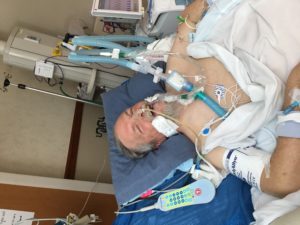Update 6/20/2015:
* This blog is re-broadcast by Mad In America re-broadcast of below blog entry, a lively discussion has already started, and the editors added this: Another example is Cork, Ireland’s Slidely slideshow accompanied by music which you can view here: http://slide.ly/view/4e64a11a8bd9e7c15cfba4724e6e91f3.
* Also, the editors helpfully added this: Many photos and videos were posted on the Stop Shock Twitter account here: https://twitter.com/stopshocknow/media.
* The original blog entry by me is as follows:
Last month almost 30 grassroot protests of electroshock were held in nine countries around the world. I had the great honor of organizing the protest here in Eugene, Oregon, USA, even though I am a survivor of psychiatric drugs and not electroshock. Electroshock is the psychiatric procedure in which electricity is run through people’s brains. Below are eight lessons that this historic event taught me.
First, here is a two-minute video of our local protest by my good friend and long-time activist David Zupan. This brief documentary shows Chuck Areford, a mental health worker, publicly apologizing to protester Fred Abbe and other shock survivors.
Eight Lessons I Learned from Our International Protest of Electroshock
1. Thank You Debra Schwartzkopff and Other Shock Survivor Organizers!
You proved once more that passion and unity are the main qualities required for resistance. Too often, people in our society mistakenly think that scientists, attorneys, professors and other esteemed professionals are the only ones who are credible. However, even though some of you shock survivors were fairly new to activism, and some of you even wrestle with cognitive disabilities caused by the shock, the true grassroots victory of International Day of Protest Against Electroshock on May 16, 2015 is undeniable.
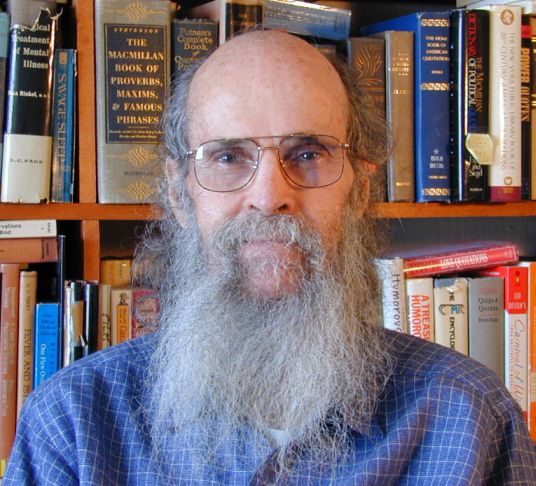
Leonard Roy Frank (July 15, 1932 – January 15, 2015)
It may be difficult for some to believe, but in a few weeks time earlier this Spring, these activists used their wits, Facebook, email lists and solidarity with one another to create an event about this very-challenging topic in many different countries at the same time. My friend and recently-deceased activist Leonard Roy Frank would have been very proud of the way the human spirit once again showed itself as unconquerable.
2. Your Protests Were A Pebble in the Pond that Continues to Reach Thousands
Here in Eugene, we had our protest in the Wayne Morse Free Speech Plaza across from our popular Saturday Market. While we had to compete with enthusiastic drummers who gather each warm Saturday, we had a good sound system thanks to musician/activist David Rogers who played some tunes. Because this free speech area is well-used, we were guaranteed to have a crowd.
Some protests that day mobilized a few dozen people, others were as small as one person, but all reached many people both online and face-to-face. That is the seeming-magic of taking action. Science has shown that the flap of a butterfly wing can influence the landing of a storm thousands of miles away. Protests, life, the mind and in fact all of reality, apparently emerge from feedback loops far from equilibrium on the edge of chaos! Shock survivors show us that we must be sure to flap your butterfly wings even if we cannot control or predict the exact outcome.
3. Activism is the Alternative that Some Will Not Name
You shock survivors and supporters pulled off these protests with your dedication even though you did not have a lot of money.
Let me give an example of an event I like that uses a lot of taxpayer money, but tends to exclude such real activism. Every year, for the past 28 years, the US federal government funds a major gathering called the Alternatives Conference, bringing together about 900 Americans with psychiatric diagnoses to discuss their local projects such as community centers, peer support groups, respite, advocacy and arts organizations, etc. I have enjoyed about ten of these meetings. However, because this event is funded by taxes there is one alternative that tends to be avoided: Activism.
Sure we all can talk about anything at the Alternatives Conferences, but if we do any significant community organizing, participants have to maintain their independence, such as going across the street and renting space from some other hotel, because the government funders are afraid of bad publicity. While understandable, it is ironic that the main way I have personally found recovery after a psychiatric diagnosis has been my four decades of activism, yet that topic is taboo at this great meeting.
Just before I fell and broke my neck in the Fall of 2012, I helped organize a protest about electroshock during the Alternatives Conference that was held that year in Portland, Oregon. The organizers of the Alternatives Conference 2012 were my friends, but became very nervous that our ferment would endanger their future government funding. My friends prevented us activists from publicly announcing our protest, and even came with hotel administrators to ask me to sign a legal disclaimer, though our protest was across the street from the conference, in a public park. You may see the 22-min. video of our 2012 protest here, it is one of the last times I spoke before my broken back impaired my voice.
On May 16, 2015 electroshock survivors showed us that even though they might not have the same millions as the US government, they made up for that with determination. Sometimes I wonder why USA federal employees are so frightened by activism when the President got his start doing community organizing in Chicago (see Barack Obama’s great book, Dreams from My Father).
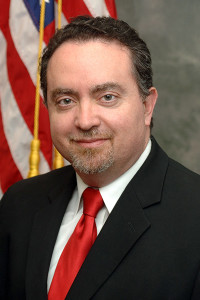
Paolo del Vecchio, Director of the Center for Mental Health Services
You may email the head of the half-billion USA agency that funds the Alternatives Conference, Paolo del Vecchio, and ask why the US taxpayer coughs up money for much of the electroshock in this country, even though our Food and Drug Administration has never approved the device, which remains Class III, experimental with no proof of safety and efficacy. For decades, I have known Paolo, who identifies as someone who has been a mental health consumer. I wonder if Paolo remembers our time in Kentucky years ago when we both keynoted an event, and I introduced him to a bunch of shock survivors who had all experienced human rights violations related to their shock.
Five years ago this July 14, Paolo, who then had a lower federal rank, invited me and more than two dozen other Americans with psychiatric labels to be in a focus group about mental health. We were able to put out a great statement about the undue influence of corporations on our mental health systems, and you may read about that action here. Paolo mainly made sure that our statement did not speak for the feds. Since our historic statement was issued, I have not heard from Paolo and he has gotten promoted!
Please email a strong but civil inquiry to Paolo and his agency:
paolo.delvecchio@samhsa.hhs.gov
I have emailed Paolo personally today, and said the following among other things:
“Will federal agencies look into the subject of human rights and electroshock now? This is more than forced electroshock, which occasionally happens in the USA even through outpatient commitment, and includes the fact that every informed consent process I have viewed has been flawed. Perhaps the worst and most subtle violation is that adequate non-drug alternatives are often not researched and provided, even though the scientific evidence shows that such alternatives are often more effective especially in the long run.”
4. Activism as a Healing Alternative

Richard “Dick” Price (1930-1985), electroshock survivor and co-founder of Esalen Institute.
Now I can hear some of you readers blaming taxpayer funding of our movement as the main reason activism is excluded at events like the Alternatives Conference (see number 3 above). However, I have seen the same problem at an independent, grassroots event. Just before I fell and broke my neck in 2012, I was generously invited to be one of the participants in an historic gathering on the coast of California in the beautiful Esalen Institute, which was co-founded by an electroshock survivor, the late Dick Price. Because Dick had been a Lithuanian-heritage Chicago-area psychiatric-survivor resident who experienced Harvard, like me, I felt some resonance.
The purpose of the Esalen gathering was to re-ignite Dick’s grand vision for creating humane alternatives to the current mental health system. Near the end of my stay, we held a support group, and I revealed how lonely I felt there because my main alternative remains activism, and while many other alternatives were discussed, it felt like activism was marginalized. This is not in anyway to disparage the activism by these amazing leaders for alternatives who gathered at Esalen. But the fact remains that too often we see a separation between activism and alternatives. For the shock survivors who organized last month’s protests, speaking up and mobilizing seemed to be a healing alternative.
5. Let Us Get Tougher With Electroshock!
Over the decades, I am proud that I have helped mobilize many people about the issue of involuntary electroshock, that is, when the procedure is given over and against the clearly explicit instructions of the recipient. Incredibly, forced electroshock is growing in parts of the world, according to Disability Rights International. Involuntary electroshock is done now and again even in the USA.
Using special court orders, some Americans living out in the community even have to report to hospitals for electroshock. That is correct, outpatient commitment can include court-ordered electroshock of Americans living in their own homes. I do not fault people if they are skeptical that such extreme violations occur in the USA, but we have the records, media coverage, witnesses, court appearances, etc. to absolutely prove this. Please just use your favorite search engine, adding the words forced electroshock, to read about two people in Minnesota who MindFreedom campaigned for who were receiving the involuntary procedure on an outpatient basis, even though they live out in the community:
Ray Sandford and Elizabeth Ellis
I continue to be outraged that involuntary electroshock exists anywhere in the world! Just about the only organized supporters of this violation are industry groups of psychiatrists. Congressperson Tim Murphy (R-PA) has a bill that would vastly expand forced outpatient procedures, an attorney has confirmed with me that this could include involuntary electroshock.
When I worked for MindFreedom, we even got the World Health Organization to oppose forced electroshock, in writing.
Human rights violations involving electroshock extend far beyond forced electroshock. For many years, I have asked to view the informed consent process for electroshock, and in all instances I discovered incorrect facts and outright distortions. But even more than force and fraud, there is a third “f” word, fear, that is a widespread human rights violation related to electroshock. Over and over I have seen people with mental and emotional difficulties prescribed a big variety of psychiatric drugs, and then when these fail they are offered electroshock. However, there are many more humane approaches which are often not provided. The fear of troubled people that the only approach is biomedical, such as drugs and shock, is a growing human rights problem.
While publicizing the protests about electroshock, I noticed that several readers said positive things about these procedures. However, the shock survivors that helped initiate these protests helped get a discussion going about this suppressed topic and that is a great public service. Breaking the silence about all electroshock is a great first step. Having a civil discussion is a start! Exactly how the human rights violations related to electroshock will be addressed remains an important topic, but we must speak out now about this brain-damaging approach and the need to offer alternatives.
7. Linking Electroshock To Global Peaceful Revolution!!!
Today, Pope Francis issued a proclamation that we need a revolution to stop global warming, or climate catastrophe as I have heard it called. Pope Francis called for everybody of all faiths, or of no faith at all, to defend Earth and unite with the cries of the poor. How does the topic of environmental collapse connect to electroshock? There are many real reasons to feel sadness and even despair, especially when climate catastrophe threatens our dear planet. When people feel upset, our society can do much better than running electricity through their brains. Unfortunately, modern medicine is now exploring high-tech super-powerful electrical magnets as an alternative to electroshock, and you may read about such Transcranial Magnetic Stimulation here. Brain damage seems to be a factor here, again; after head trauma there can be personality changes that some psychiatrists interpret as improvement.
After our protest in Eugene, several of us carried our signs and marched a couple of blocks. We stopped for a moment at the nearby Summit Bank which was closed that day, because the hours are weekdays. The reason we stopped there, is that the leader of Summit Bank is the newly-elected leader of our local Eugene Area Chamber of Commerce. I have been helping to mobilize a peaceful effort for five years to have our local chamber speak up and say that the US Chamber in Washington, D.C. does not speak for them about global warming. The well-respected climate group, 350, has had a campaign for about five years to ask local chambers to distance themselves from the US Chamber about this climate catastrophe.
I call the worst-case scenarios for run-away climate catastrophe, in which feedback loops such as methane release amplify global warming to such a chaotic extent that we risk eliminating all human existence, and perhaps all multi-cellular life on Earth, “normalgeddon” and you may read a special landing page I have created for this topic here:
www.normalgeddon.com
Surprisingly, after my many blog posts about climate catastrophe, I have read some push-back from several skeptics who do not seem very worried about the risk of human-caused global warming, even the well-researched high-certainty of sea level rise, etc. that can be read in the reports of the Intergovernmental Panel on Climate Change here, which convenes more scientists than any other project in human history.
While the IPCC focuses on problems from global warming that are highly-certain, I am more worried about the real risk, even if it is uncertain, of a Venus-like climate catastrophe that may end all life here as we know it, and future generations. Hey, Never Again is a slogan that really means never again! However, normalgeddon would wipe out all humanity so mathematically that would be many “agains”! Even an uncertain risk of such a normalgeddon deserves more discussion today, because sweeping upsetting topics under the table is not good for mental wellness!
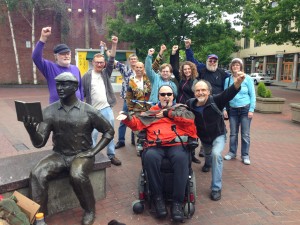 At the end of our protest here in Eugene, a few of us posed around a statue of the author Ken Kesey that is in the center of our town. Ken wrote the book One Flew Over the Cuckoo’s Nest, and he told me before he died that he had a friend splice some electrical extension cord wire so that while Ken lay on the floor, the friend touched Ken’s temples with the bare wires and Ken experienced electroshock in a very crude way. Ken had seen medical electroshock when he worked for a while in a psychiatric institution. Ken said he believed in experiencing at least once and he wanted to research electroshock for his novel. When his friend touched Ken’s temples, Ken later reported that every cell in his body cried out “No!” After that, Ken told me that he no longer believed in experiencing everything once! Ken opposed electroshock, and the image of his protagonist receiving shock remains an icon of this procedure today, even though some details are changed; the brain and electricity are still the same as when Ken wrote this.
At the end of our protest here in Eugene, a few of us posed around a statue of the author Ken Kesey that is in the center of our town. Ken wrote the book One Flew Over the Cuckoo’s Nest, and he told me before he died that he had a friend splice some electrical extension cord wire so that while Ken lay on the floor, the friend touched Ken’s temples with the bare wires and Ken experienced electroshock in a very crude way. Ken had seen medical electroshock when he worked for a while in a psychiatric institution. Ken said he believed in experiencing at least once and he wanted to research electroshock for his novel. When his friend touched Ken’s temples, Ken later reported that every cell in his body cried out “No!” After that, Ken told me that he no longer believed in experiencing everything once! Ken opposed electroshock, and the image of his protagonist receiving shock remains an icon of this procedure today, even though some details are changed; the brain and electricity are still the same as when Ken wrote this.
We protesters gathered around the statue of Ken reading to his grandchildren because we wanted to thank Ken for bravely writing about electroshock. Yes, I realize that in my opinion and in the opinion of many others that Ken wrestled with substance problems. However, Ken’s rebellious prankster spirit in this book, where he calls normality the Combine, should inspire us all. After I fell I deal with paralysis of all four my limbs and even one vocal cord, but I see that the wider society, what is mistakenly called “normal,” is far more paralyzed than me and had better wake up soon!
Thanks electroshock survivors for taking action and showing all of our society how to shake off this moral paralysis, now!
8. We Are Our Own Media!
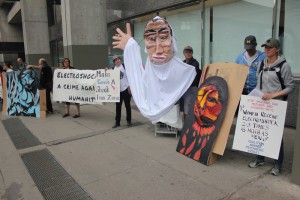
Toronto protest of electroshock on May 16, 2015 with street theatre (photo by Graeme Bacque)
I received a photo album from activist Graeme Bacque that has dozens of photos from the protest of electroshock that was held in Toronto. A special thing about this protest is that by coincidence the American Psychiatric Association was having their huge Annual Meeting nearby.
We can learn from other activists, many of them young, that after a protest we must cover our own events. We can upload still-photos, a brief paragraph description and for those who are able, videos.
In order for us to keep on complaining about corporate media, we first need to report on our own events and with 21st century technology, we can do that. For example, way to go Graeme, whose photo from Toronto is on the right, and you can view his album on Flickr here: Graeme’s Photo Album of Toronto 2015 Electroshock Protest
My friend and psychiatric survivor/attorney Jim Gottstein, from his group in Alaska, PsychRights, helpfully compiled this online list of protests about electroshock last month, and you are invited to click around, see the photos, play any videos, and enjoy:
http://networkagainstpsychiatricassault.org/ElectroshockDocs/Protests.htm
My late friend Leonard Roy Frank would have had a birthday on July 15. In case you have not already started a Global Peaceful Revolution already, and you would like a day to start a GPR, please join with me this July 15th and start! This would be a great gift to a shock survivor, studier of nonviolent revolution, editor of quotes and a leader with a great sense of humor.
Hey, if Americans celebrate revolution on July 4, and French celebrate July 14, then how about we start a Global Peaceful Revolution on July 15?
What a nice way to reflect on Creative Maladjustment Week which is every July 7-July 14!
You may visit a facebook page about International Association for the Advancement of Creative Maladjustment here.
Thanks all shock survivors, organizers of last month’s protests, and everybody who continues to break the silence about electroshock, and helps to lead a Global Peaceful Revolution.
Read More
 A US Senate committee is supposed to approve a controversial Trump appointee this Tuesday, 1 August 2017. You may not have heard about this in mainstream media, or even the alternative media, though I have been covering this topic for months!
A US Senate committee is supposed to approve a controversial Trump appointee this Tuesday, 1 August 2017. You may not have heard about this in mainstream media, or even the alternative media, though I have been covering this topic for months!


